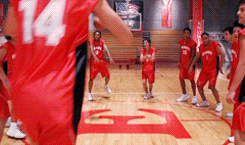Where are we going you might ask? Drumroll please…

Source: Giphy
THE ARCHIVES! That’s where!
Now I know, I’m kind of a nerd for being excited about getting to do research in my school library, but if you think about it, it’s really quite exciting. We get to venture into uncharted territory, looking for whatever resources we want about whatever topic we want. How often does that happen in school? Not nearly enough if you ask me.
So, What Exactly am I Looking For?
Although I don’t know exactly what I’m looking for, I have a general idea. I’m really interested in learning about Santa Clara University in the 1980’s and looking at how it has changed in the past 37 years. I particularly want to look at how the campus has changed physically (like the re-routing of the Alameda), how education has changed as a result of the digital revolution and how social norms and interactions have changed with a new generation.
Why the 80’s? Well, my mom was a student here from 1981-1985, so I am curious to see how her Santa Clara differs from my Santa Clara. Also, I have a few people, including my mom, that I could interview and use as secondary sources to supplement my research.
Game Plan
After reading various articles on archival research, I feel like I’m ready to tackle my first research paper. Here’s my game plan for the journey into the archives.
-
Get My Head in the Game

Source: Giphy
I often think of research as just collecting information to meet an assignment’s requirements. Instead, I have to think of research as “the discovery and purposeful use of information” (Greene 19).
-
Understand My Role as Researcher
 I am more than an external observer or narrator. In the words of Gaillet, “the researcher becomes a part of the project” and acts as “a filter and a lens” (36-37). To be effective, I must become a “scholarly storyteller” (36).
I am more than an external observer or narrator. In the words of Gaillet, “the researcher becomes a part of the project” and acts as “a filter and a lens” (36-37). To be effective, I must become a “scholarly storyteller” (36). -
Consider How Sources Fit into My Work

Source: Giphy
When I find sources, I need to be aware of it’s “rhetorical situation – the author, the intended audience and purpose of the document” (Tirabassi 173). With this information, I can cross-reference other sources, while also adding my own “assumptions and claims” to “substantiate the story I tell” (Gaillet 35).
-
Pay Attention to Details

Source: Giphy
Gaillet recommends documenting the smallest details, like “the paper, watermarks, binding, print or handwriting, marginalia” (35). It is also helpful to “take note of where a document is found” since its categorization might tell you more about where to find similar sources (Tirabassi 175).
-
Enough is Enough

Source: Giphy
At some point, all research must come to a close. Instead of endlessly searching for more sources, I need to realize the time to walk away and find closure.
All Those Authors I Kept Citing
Gaillet’s article, “Archival Survival: Navigating Historical Research” is unfortunately unavailable online.
